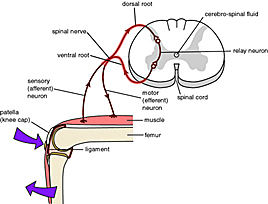Reflectory reaction
Editor-In-Chief: C. Michael Gibson, M.S., M.D. [1]
A reflex action is involuntary and almost instant movement in response to stimulus.[1] In most contexts, especially involving humans, a reflex action is mediated via the reflex arc (although this is not always true in other animals, or in more casual usage of the term 'reflex'.)
Reflexes are tested as part of a neurological examination to assess damage to or functioning of the central and peripheral nervous system.
Reflexes may be trained, such as during repetition of motor actions during sport practice, or the linking of stimuli with autonomic reactions during classical conditioning.
Reaction time
For a reflex, reaction time or latency is the time from the onset of a stimulus until the organism responds.
In animals, reaction time to visual stimuli is typically 150 to 300 milliseconds.[2]
Human reflexes

Reflex actions include:
Tendon reflexes
The deep tendon reflexes provide information on the integrity of the central and peripheral nervous system. Generally, decreased reflexes indicate a peripheral problem, and lively or exaggerated reflexes a central one.
- Biceps reflex (C5, C6)
- Brachioradialis reflex (C5, C6, C7)
- Extensor digitorum reflex (C6, C7)
- Triceps reflex (C6, C7, C8)
- Patellar reflex or knee-jerk reflex (L2, L3, L4)
- Ankle jerk reflex (Achilles reflex) (S1, S2)
- Plantar reflex or Babinski reflex (L5, S1, S2)
While the reflexes above are stimulated mechanically, the term H-reflex refers to the analogous reflex stimulated electrically, and Tonic vibration reflex for those stimulated by vibration.
Reflexes involving cranial nerves
| Name | Sensory | Motor |
| Pupillary reflex | II | III |
| Accommodation reflex | II | III |
| Jaw jerk reflex | V | V |
| Corneal reflex, also known as the blink reflex | V | VII |
| Caloric reflex test/Vestibulo-ocular reflex | VIII | III, IV, VI + |
| Gag reflex | IX | X |
Reflexes in infants only
Newborn babies have a number of other reflexes which are not seen in adults, referred to as primitive reflexes.[3] These include:
- Asymmetrical tonic neck reflex (ATNR)
- Grasp reflex
- Hand-to-mouth reflex
- Moro reflex, also known as the startle reflex
- Sucking
- Symmetrical tonic neck reflex (STNR)
- Tonic labyrinthine reflex (TLR)
Other reflexes
Other reflexes found in the human nervous system include:
- Anocutaneous reflex
- Bulbocavernosus reflex
- Escape reflex
- Mammalian diving reflex
- Oculocardiac reflex
- Optokinetic reflex
- Photic sneeze reflex
- Scratch reflex
- Withdrawal reflex
- Muscular defense
Processes such as breathing, digestion, and the maintenance of the heartbeat can also be regarded as reflex actions, according to some definitions of the term.
See also
References
- ↑ Purves (2004). Neuroscience: Third Edition. Massachusetts, Sinauer Associates, Inc.
- ↑ "Human Benchmark: Reaction Time Statistics". Retrieved 2007-10-11.
- ↑ http://www.fpnotebook.com/Neuro/Exam/NrlgcExm.htm
Template:Nervous system physiology
Template:Reflex
ca:Reacció reflexa
cs:Reflex
da:Refleks
de:Reflex
et:Refleks
eo:Reflekso
gl:Reacción reflexa
id:Refleks
it:Riflesso
he:רפלקס
lv:Reflekss
lt:Refleksas
nl:Reflex (biologie)
no:Refleks
sk:Reflex
fi:Refleksi
sv:Reflex (medicinsk term)